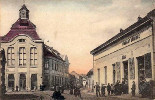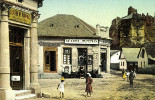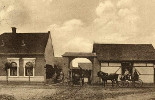Excerpt from the book RNDr. Jozef Klinda " V tieni vyhasnutých sopiek "
The annihilation of 42 348 Jews from south Slovakia did not leave the Jewish community – the holy association (chevra
kadischa), founded in Fiľakovo in 1820, after a traumatic era
of stagnationthat followed after the
destruction of the Fiľakovo castle by the Turkish forces and
their ally Thököly (1682) - unscathed.
The esteemed chairman of this congregation, Lőrinc Diamant
(1897 – 1931), the owner of the
corner shop on the main street, would also surely not escape the
holocaust had he not misfortunately
died of blood poisoning in 1931. The Jews built a synagogue and
a school according to the project of
Adolf Aaron Büchler in the Jewish quarter
near the Berchtold mansion (later
known as Stephani‘s/Herold’s mansion).Away from the city, on a slope under the Rooster Hill, they
founded a cemetery. They were permitted to found the cemetery on the Savol road not far from
Gallows Hill, where in 1831 the brigands Misurak and Lazar were executed. Several Jews owned
businesses and houses on the Main road and the new town constructed closer to the Railway station. In
1861 75 Jews were living in Fiľakovo, in 1900 there a hundred more. They also flourished in turbulent
times of political changes. After the foundation of Czechoslovakia, the main rabbi in the synagogue was RabbiSamuel Jungreis
Volf with his helper Samuel Reinitz (since 1927 with Max Holländer and Eugen Grünsz). Samuel Freilich and Emanuel
Schwarcz were teaching in the Jewish school, where they were joined by Talmudist Emanuel Lorber and in 1937 David Klein.
They survived anti-Semitic sentiments that surfaced after trader Lőwy was absurdly accused in the case of the disappearance
of Jancsi Poroszlai, who was last seen helping Mr. Lőwy with his baggage at the railway station on fourth ofNovember 1920.
This started a campaign against the Jews. The windows and doors on their houses and businesses were barricated. The police
later solved the tense situation, when the missing teenager was found near
Čamovce a few
kilometers to the east of Fiľakovo. Even after the troublesome youth was
thoroughly disciplined by
his father, no one apologized to Lőwy, although the animosity against the Jews
disappeared for a
time: until 1944 when German soldiers moved into the town and murdered
almost the entire family
of Jonas Lőwy. They tried to force his son Leopold (1892 – 1944) to tell them
where he hid his gold.
He withstood their torture, did not tell them, and died together with his wife
Sára, two sons, two
daughters and a two months old baby in a gas chamber after they were deported to Auschwitz. The same fate met Jonas
Lőwy’s second son Hugo with his daughter Lea, her husband and twelve children. Only Jonas‘s daughter Paula survived.
Everything changed in 1938, especially after fifth of April 1944, when the Jews had to wear the yellow star. In the same
year several were transported to the Jewish ghetto in Lučenec, including Rabbi Sándor Büchler, born in Fiľakovo
(24September 1870) and later – to šoa. Only a few of them were fortunate enough to escape. Amongst the refugees was a
teenage Frank Lőwy (born on 22. October 1930 in Fiľakovo), son of Hugo Lőwy, founder of Lőwy Institute of International
Policy and a longstanding chief of the Australian Football Association. Frank fled to Budapest and through France to
Palestine. There, as a member of the Jewish military organization Haganach (Defenses), he fought for the creation of Israel,
announced by David Ben Gourion on May 14 1948. Later he moved to Australia where he founded a trading empire: Westfield
Group. The Jewish street was renamedshortly after that to Street of Jókai Móra. The synagogue was desecrated during the
war by being turned into a barn and silo. Jewish property was aryanized - confiscated. After the war only 51 of them
returned on 9. June 1946, survivors of a horrible nightmare, or better-said survivors of the monstrous reality of the
wartime. Among those deported to
Auschwitz in 1944 there were few survivors. The Büchlers,
Susickys, Grossmans, Weimanns,
Blitzs, Róths, Menzels and the majority of Lőwys, Krämers and
Kleins did not survive. The gas
chamber also claimed the life of doctor Edmund Gömöri, wood
trader Jakub Haupt, tradeswomen
Priška Kohn-Weiss and Rozália Glück-Stein and other. In 1945
traders Jakub Haupt and Stefan
Susicky died in Mauthausen. Among the survivors of the holocaust
were the Schwarcz family,
Blumenthal family, Braun family, Rogner family, Stein family,
Weiss family, Cinka family, some of the Bernáth family, Haupt family and Gömöri family, single survivors were John Abeles,
Eva Fränkl, Solomon Glück, Margita Hoffmann, Cecilia Königsberg, Arnošt Kohn, Alexander Kessler and Esther Molnár. They
all lost their lovedones, illusions, but not their faith. The Jewish cemetery behind the Kovosmalt factory fell into disrepair
after the last funeral of Lenka Bernathova in 1961. Nobody took care of it. The amount of stones laid onto the graves by
relatives and acquaintances of the deceased reduced to a bare minimum. Thorn trees and bushes covered the gravestones.
Historians, paleontologists, ornithologists, sometimes visited the place, a visitor of the nearby wine cellars stumbled upon it by
accident.A lot more often,Hoopoes from old hollow trees on the Rooster Hill visited the site. Impressive orange-brown birds
with black and white stripes, with aigrettes on their heads. Divine creatures.
People believed since
time immemorial that Hoopoes are drawn to places of sorrow that can cause the
„death of spirit“.
Two Jews deported from Slovakia, Alfred Wetzler and Rudolf Vrba-Rosenberg,
were also forgotten.
They were penmen in Auschwitz, from where they managed to escape on April 7,
1944, and tell the
world about the realities of an extermination camp.The hardships and graves of
Jews from Fiľakovo
were also forgotten. If it was not for the financial aid of Mr. Lőwy from far away
Sydney, Australia,
in 1998, the Jewish cemetery in Fiľakovo would cease to exist, and Hoopoes would no longer visit the site. They would not
impress visitors and passers-by with their colorful feathers and elegant demeanor. Ten years after the cemetery’s repair,
they were not seen in the vicinity. Maybe they did not like the changes on the site; maybe the new gas station built in the
nearby old sand pit was not to their liking. They vanished without a trace until the end of May 2008, when they were again
seen hopping from one gravestone to another.They looked onto the gravestones as if reading the old Hebrew inscriptions.
After performing their magical ritual, they flew off into the blue sky above the Rooster Hill. The next day media informed
that the 9th president of Israel, Simon Peres, solely declared the Hoopoe (after the people of Israel voted it by the
occasion of the 60th anniversary of the founding of Israel) the national bird of Israel.




